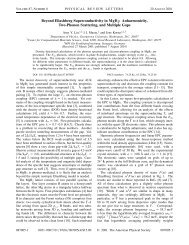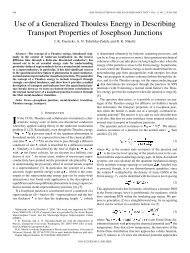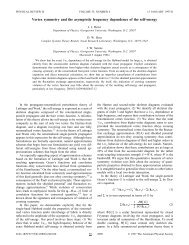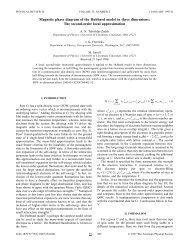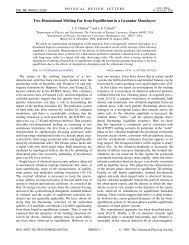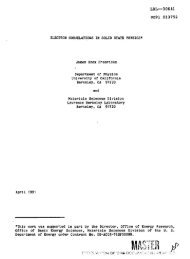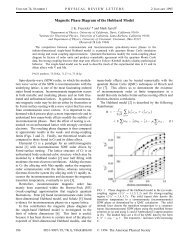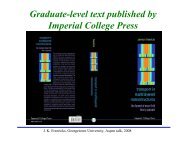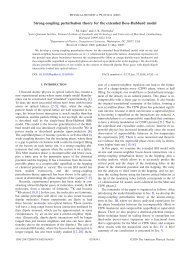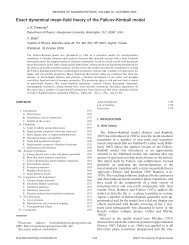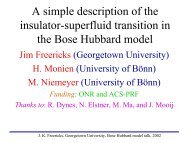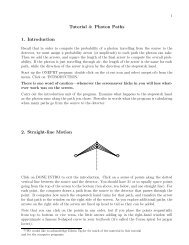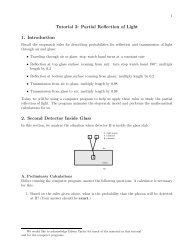Tuning a short coherence length Josephson junction through a ...
Tuning a short coherence length Josephson junction through a ...
Tuning a short coherence length Josephson junction through a ...
You also want an ePaper? Increase the reach of your titles
YUMPU automatically turns print PDFs into web optimized ePapers that Google loves.
<strong>Tuning</strong> a <strong>short</strong> <strong>coherence</strong> <strong>length</strong><br />
<strong>Josephson</strong> <strong>junction</strong> <strong>through</strong> a<br />
metal-insulator transition<br />
J. K. Freericks, B. Nikolić, and P. Miller *<br />
Department of Physics, Georgetown University, Washington, DC 20057<br />
*<br />
Department of Physics, Brandeis University, Waltham, MA<br />
freericks@physics.georgetown.edu<br />
(202) 687-6159 (voice) (202) 687-2087 (fax)<br />
Most recent preprint: cond-mat/0001269<br />
J. K. Freericks, Georgetown University, <strong>Josephson</strong> Junction talk, 2001
<strong>Josephson</strong> Tunnel Junctions<br />
I<br />
S I S<br />
• A Superconductor-Insulator-<br />
Superconductor sandwich can tunnel<br />
coherent Cooper pairs (<strong>Josephson</strong><br />
current) or can tunnel broken pairs<br />
(quasiparticles) <strong>through</strong> the barrier.<br />
I<br />
V<br />
Ic<br />
V<br />
∆<br />
• If the phases of the superconducting<br />
wavefunctions differ, then there is a<br />
DC <strong>Josephson</strong> current I=Ic sin θ.<br />
• The I-V characteristic is highly<br />
nonlinear at low voltages, leading to<br />
the possibility of important<br />
electronics applications (based on<br />
latching technologies which are slow<br />
and subject to “punch-<strong>through</strong>”,<br />
because of the hysteretic IV curves).<br />
J. K. Freericks, Georgetown University, <strong>Josephson</strong> Junction talk, 2001
<strong>Josephson</strong> Proximity-Effect Junctions<br />
I<br />
I<br />
S N S<br />
V<br />
Ic<br />
V<br />
• A Superconductor-Normal metal-<br />
Superconductor sandwich where the<br />
weak link between superconductors<br />
occurs <strong>through</strong> the proximity effect.<br />
• Andreev reflection at the N-S<br />
boundaries leads to sub-gap bound<br />
states that carry the pair current.<br />
• Single-valuedness of the IV<br />
characteristic allows for nonlatching<br />
technologies like RSFQ<br />
logic.<br />
• Goal is to optimize the switching<br />
speed of these <strong>junction</strong>s by<br />
maximizing IcRn, while<br />
maintaining nonhysteretic<br />
behavior.<br />
J. K. Freericks, Georgetown University, <strong>Josephson</strong> Junction talk, 2001
Digital Electronics and RSFQ logic<br />
• Rapid single-flux quantum logic is used for highspeed<br />
applications. A loop of superconducting<br />
material has one JJ interrupting it. The absence or<br />
presence of a flux quantum in the loop is the binary 0<br />
and 1 of the device. (Much faster than latching<br />
technologies.)<br />
• The flux is changed by generating a voltage pulse<br />
<strong>through</strong> the <strong>junction</strong>, whose time integral is equal to a<br />
flux quantum. Since the voltage scale is set by the<br />
product IcRn, which is on the order of a few mV in<br />
low-Tc superconductors, operating speeds of up to<br />
770 GHz have been already demonstrated.<br />
• High Tc <strong>junction</strong>s, with IcRn products larger than 20<br />
mV can possibly produce speeds in excess of 1 THz!<br />
• The goal for fast electronics is to optimize the IcRn<br />
product of a <strong>junction</strong>, while maintaining<br />
nonhysteretic IV curves.<br />
J. K. Freericks, Georgetown University, <strong>Josephson</strong> Junction talk, 2001<br />
X<br />
Binary 0, no flux<br />
X<br />
Binary 1, one flux quantum
Navy Interest<br />
• High precision, high speed, analog-digital converters for the<br />
Advanced Multifunction Radio Frequency System concept for<br />
use in radar, electronic warfare, and communications.<br />
• Long-term specs include 12 bit ADC with 1GHz of bandwidth.<br />
Processing speed is more important than resolution.<br />
• Short-term goal is a 20 bit ADC with 20MHz of bandwidth.<br />
• Superconducting digital electronics may provide the solution.<br />
• The theoretical calculation and modeling is a scalable massively<br />
parallel solution to a scientific problem.<br />
• Work would have an impact on the HTMT JJ-based petaflop<br />
computer which could be competitive with IBM’s blue-gene<br />
project. (But the JJ computer may no longer be funded.)<br />
J. K. Freericks, Georgetown University, <strong>Josephson</strong> Junction Talk, 2001
Optimization of the speed of a JJ<br />
SC<br />
Weak-link<br />
region<br />
SC<br />
• Insulating barriers found in tunnel<br />
<strong>junction</strong>s have a high resistance and a<br />
low <strong>Josephson</strong> current.<br />
• Metal barriers found in proximityeffect<br />
<strong>junction</strong>s have a low resistance<br />
and a high <strong>Josephson</strong> current.<br />
• Is the speed optimized (i.e. the<br />
product IcRn maximized) when the<br />
barrier lies near the metal-insulator<br />
transition? What type of material<br />
produces the best <strong>Josephson</strong> <strong>junction</strong><br />
weak-link region?<br />
• Here we examine what happens as the<br />
barrier is tuned <strong>through</strong> a metalinsulator<br />
transition.<br />
J. K. Freericks, Georgetown University, <strong>Josephson</strong> Junction talk, 2001
Many-Body Formalism<br />
• Inhomogeneous system, with planes stacked<br />
along the z-direction.<br />
FK<br />
• H= −Σ t c* c + Σ U n n + Σ U (n + n ) w<br />
ij iσ jσ i i↑ i↓ i i↑ i↓ i<br />
• Hopping, site energy, Coulomb interaction,<br />
and the impurity interaction can vary from<br />
one plane to another.<br />
• Local dynamical correlations are explicitly<br />
included for each plane via the dynamical<br />
mean field theory. The self-consistency<br />
relation is now modified to include effects<br />
that couple the effective medium between<br />
the planes.<br />
• The superconductor is described by the H-F<br />
approximation, which is identical to a selfconsistent<br />
solution of the BogulubovdeGennes<br />
equations for a <strong>short</strong>-<strong>coherence</strong><br />
<strong>length</strong>, s-wave superconductor.<br />
i<br />
i+1<br />
i+2<br />
J. K. Freericks, Georgetown University, <strong>Josephson</strong> Junction talk, 2001
Conventional Models<br />
SC<br />
Weak-<br />
Link<br />
SC<br />
Ε F<br />
S Barrier S<br />
• BTK model, interface scattering, no<br />
self-consistency, no electronelectron<br />
interactions in the barrier,<br />
no bandstructure effects. Simple<br />
exercise of matching boundary<br />
conditions for plane waves.<br />
• Generalizations to include<br />
bandstructure effects (Fermi<br />
wavevector mismatch, varying<br />
effective mass) are easy to include.<br />
• Self-consistency and especially<br />
correlations have been much more<br />
difficult.<br />
• All of these effects are<br />
automatically included in our<br />
approach!<br />
J. K. Freericks, Georgetown University, <strong>Josephson</strong> Junction talk, 2001
Metal-insulator transition<br />
J. K. Freericks, Georgetown University, <strong>Josephson</strong> Junction talk, 2001<br />
The Falicov-Kimball<br />
model has a metalinsulator<br />
transition<br />
that occurs as the<br />
correlation energy U is<br />
increased. The<br />
interacting DOS shows<br />
that a pseudogap<br />
phase first develops<br />
followed by the<br />
opening of a true gap<br />
above U=4.9 (in the<br />
bulk). Note: the FK<br />
model is not a Fermi<br />
liquid in its metallic<br />
state since the lifetime<br />
of excitations is always<br />
finite.
Bulk superconducting properties<br />
• T c =0.11t,<br />
∆=0.198t,<br />
2∆/k B T c =3.6---<br />
behaves like a<br />
BCS<br />
superconductor<br />
• Bulk <strong>coherence</strong><br />
<strong>length</strong> ξ 0 =3.7a=<br />
v F /π ∆ ---<strong>short</strong><br />
<strong>coherence</strong> <strong>length</strong><br />
superconductor<br />
J. K. Freericks, Georgetown University, <strong>Josephson</strong> Junction talk, 2001
Proximity effect<br />
Thin barrier (N b =1). Note how oscillations<br />
develop as U becomes larger than 3 and<br />
how the anomalous average increases for<br />
U> 12 and is enhanced for U > 18!<br />
• Thick barrier (N b =20). Note how the<br />
anomalous average is reduced as the<br />
barrier makes the transition to an insulator.<br />
The anomalous average decreases rapidly<br />
within the pseudogap phase as the<br />
insulator is approached. The sharp<br />
oscillations within the insulator decay on<br />
the order of the bulk <strong>coherence</strong> <strong>length</strong>.<br />
J. K. Freericks, Georgetown University, <strong>Josephson</strong> Junction talk, 2001
Current-phase relation (thin barrier)<br />
• When Ic<br />
approaches the<br />
bulk critical<br />
current, little<br />
total phase can<br />
be put across<br />
the <strong>junction</strong>.<br />
• As the barrier<br />
becomes more<br />
insulating, the<br />
current phase<br />
relation<br />
approaches<br />
sinusoidal<br />
behavior.<br />
J. K. Freericks, Georgetown University, <strong>Josephson</strong> Junction talk, 2001
Critical current and resistance (thin)<br />
• The semilogarithmic plots<br />
show the expected<br />
decrease in Ic and<br />
increase in Rn. The IcRn<br />
product becomes constant<br />
for a thin barrier, showing<br />
the Ambegaokar-Baratoff<br />
behavior (renormalized by<br />
10%).<br />
• The biplane barrier does<br />
not show AB behavior, but<br />
rather continues to<br />
increase it’s characteristic<br />
voltage as the correlations<br />
increase. However, the IV<br />
characteristic must<br />
become hysteretic in the<br />
insulating phase.<br />
J. K. Freericks, Georgetown University, <strong>Josephson</strong> Junction talk, 2001
Critical current and resistance (thick)<br />
• For N b =5, the<br />
characteristic voltage first<br />
decreases, then shows a<br />
sharp increase and peak<br />
just on the insulating side<br />
of the metal-insulator<br />
transition.<br />
• The thick <strong>junction</strong><br />
(N b =20), has a sharp<br />
reduction of the<br />
characteristic voltage<br />
because of the strong<br />
temperature dependence<br />
of the resistance in the<br />
insulating phase.<br />
J. K. Freericks, Georgetown University, <strong>Josephson</strong> Junction talk, 2001
Critical current versus barrier thickness<br />
ξ 0 =6.75<br />
x=-0.4<br />
ξ 0 =2.96<br />
x=-0.45<br />
ξ 0 =0.67<br />
x=-0.5<br />
• Fit of the critical<br />
current versus<br />
barrier thickness<br />
for three cases:<br />
(i) weakly<br />
correlated<br />
metal; (ii)<br />
strongly<br />
correlated metal<br />
(pseudogap); and<br />
(iii) correlated<br />
insulator.<br />
I<br />
c<br />
=<br />
AN<br />
x<br />
b<br />
exp[ −N<br />
/ ξ ]<br />
b 0<br />
J. K. Freericks, Georgetown University, <strong>Josephson</strong> Junction talk, 2001
Characteristic voltage versus Thouless energy<br />
Insulator<br />
Dirty Metal<br />
Kulik-<br />
Omelyanchuk<br />
• Quasiclassical theory predicts a universal form for dirty metals, but<br />
we see different behavior for the correlated insulator which predicts a<br />
greater sensitivity to “intrinsic pinholes”.<br />
J. K. Freericks, Georgetown University, <strong>Josephson</strong> Junction talk, 2001
Characteristic voltage (Screened-dipole layer barrier)<br />
Screened dipole<br />
layer barrier<br />
“teaser”---<br />
characteristic<br />
voltage decreases<br />
sharply in clean<br />
“dipole”-based<br />
SINIS <strong>junction</strong>s.<br />
• The characteristic voltage is always less than the “planar” contact<br />
limit of the bulk critical current times the Sharvin resistance. Note<br />
how the voltage decreases dramatically with thickness.<br />
J. K. Freericks, Georgetown University, <strong>Josephson</strong> Junction talk, 2001
Outstanding Technical Issues<br />
• Incorporate charge redistribution physics, correlations, plus<br />
long-range spatial ordering, to describe behavior of grain<br />
boundaries in high-Tc. (Collaborations being developed with<br />
Mannhart’s group in Augsburg.)<br />
• Generalize from s-wave to d-wave to examine high-Tc systems<br />
better.<br />
• Add spin-dependent physics to model hybrid superconductorferromagnetic<br />
structures and to understand spin-scattering effects.<br />
• Generalize the formalism to calculate nonequilibrium effects<br />
needed to determine IV characteristics and to calculate subgap<br />
structure.<br />
• Applications possible to other devices (spintronics and hybrids).<br />
J. K. Freericks, Georgetown University, <strong>Josephson</strong> Junction talk, 2001
Conclusions<br />
• Examined properties of a <strong>Josephson</strong> <strong>junction</strong> tuned <strong>through</strong><br />
a metal-insulator transition.<br />
• Saw that optimization of the characteristic voltage requires a<br />
careful understanding of the correlations, thickness, and<br />
operating temperature of the device.<br />
• Found an optimization on the insulating side of the metalinsulator<br />
transition for moderately thick barriers.<br />
• Discovered that temperature effects and “intrinsic<br />
pinhole” effects can both be quite strong when the system<br />
sits close to the quantum critical point of the metal-insulator<br />
transition, which can help understand some difficulties with<br />
maintaining low spreads in high-Tc devices.<br />
J. K. Freericks, Georgetown University, <strong>Josephson</strong> Junction talk, 2001



